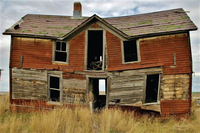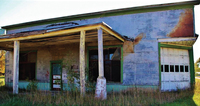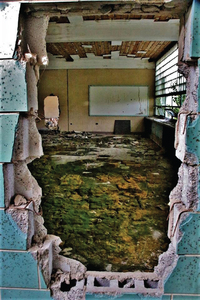Ever felt that exhilarating rush of curiosity that hits you when looking down a not so well traveled road and spotting in the distance an old barn, farmhouse, or a country schoolhouse. Much of the appeal to me is the time machine affect, I guess. The idea of urban exploration as a journey into another world, one that sits right alongside our everyday lives: And there is the unexpected beauty of these buildings, which attracted me in the first place. It was not simply about enjoying the fun of exploring and the fascination I experienced while shooting these places, but to play a part in creating a lasting legacy. And why my husband and I devote so much time to finding, entering, and documenting these forgotten buildings and places. The frail beauty of once lived in spaces, we saw as an opportunity to properly document through photography a site before it was gone for good. It takes some imagination to look at a derelict building and see beauty in its broken windows and rotten floorboards. And I try to shy away from the notion that there is anything creepy about these places, although, I will admit I have had the hairs stand up on the back of my neck at some locations. And in those cases, I usually moved pretty quickly through capturing what I saw and then moved on. But in most situations when entering a structure, they are actually quite remarkably peaceful and beautiful. I guess if there is a message, it is not that they are creepy, but it is the story of people doing the best they could at the time and about the legacy that we leave to show a life well lived.
The images of decaying buildings are, in and of themselves, a legitimate art form and that the sense of impermanence that comes with looking at decaying buildings is, in itself, fascinating. The level of decay is incredibly alluring, and I will never forget seeing this sun-drenched wall with about five coats of different color paint curling with age, all at different rates. I literally stopped dead in my tracks to appreciate it. It was unforgettable and has inspired a lot in my life since. I feel that analyzing images of abandoned structures, has a lot to teach us, not just about our recent past, but also about our present times and the future ahead. I am drawn to this due to the heavy emotions of tragedy, injustice and waste that are elicited when you see something so beautiful decay, the haunting images of places reduced to just a shadow
of their former selves. Such as uninhabited towns, I could not help but see them as post-apocalyptic, visions of what the future might look like if human history ended with this era. And there are certainly some cases in which ruined buildings feel like pre-made sets for horror movies, complete with eerie doll parts or spooky backstories. The results are a somewhat romantic look at what occurs when humans move forward, leaving their past behind. For every country home that is in relatively good shape, there are many other abandoned buildings with paint slowly peeling away, exposing the skeleton of the architecture. It is as though time strips back each building, gradually returning them to their natural state. Occasionally, we already see nature taking hold and reclaiming the land that was once its own. I like seeing the often-strange beauty which is about to be lost forever.
Though devoid of humans, these spaces are not lacking objects. While abandoned by people, they still remain containers for the material possessions left behind. Furniture, papers, pianos, books, chalkboards, and artwork fill the photos like ghosts left to haunt these once bustling structures. In their presence, and in the absence of people, we are left to fill in the blanks. Nowhere is safe from the march of time and in many ways, photographs serve as a last gasp for these forsaken buildings—an endcap to their lifecycles. The more ways we cut ties with the past the more we diminish our future. Even if the only way we preserve the memory of a building is through images then that is worth something. Through these images, we are studying not bygone eras, but ourselves, recording ourselves, our lives, and the structures we left behind for future generations. People want to leave a legacy because they want to feel that their life mattered, we weave this idea into everything we do.
We all want to be known as someone who truly made a difference, to leave an imprint on this world and to leave behind something that can make the future a little brighter. From the time we are kids, we’re told that we are special and we are destined for something wonderful, that we can take the world by the horns and that whatever we set our minds to we can accomplish, that it’s our world and what we choose to do with it is up to us. Sometimes it is easy to lose perspective of where exactly we are in the world and why we are here.
Just a few decades back – in the era of film – each click of the camera shutter was made with such careful thought and a kind of mindfulness in knowing you only had so many chances…only so many chances to freeze this minute in time and turn it into something you can hold. Most of our lives we have chosen not to live in fear despite being surrounded by dangers and a million ways to die. Life is meant to be lived and we should be doing that, we must not be afraid, we must not hide and stop living. Define history for yourself however you see fit, do not limit yourself. Live a life true to yourself, be authentic, and be you.
Ultimately the great images of our life are those that make us feel something. There are reasons to be grateful everywhere if you take the time to look for them.
Everyone has a story to tell, so, tell on and leave behind a dramatic legacy!
Writing this column has taken me on a journey of sorts, I never expected to get comments from time to time and it is humbling. Want to share your thoughts, feelings or even have a story idea; I would love to hear from you. Please email me, ang@yankton.net, and thanks for reading! Ang





